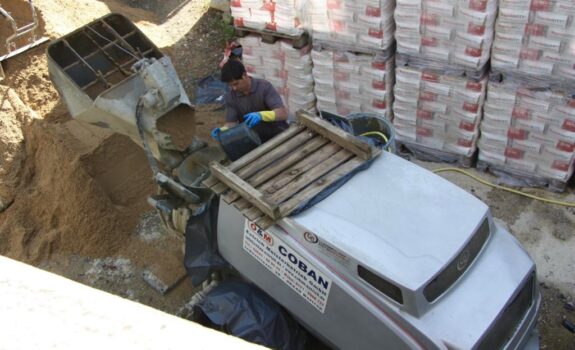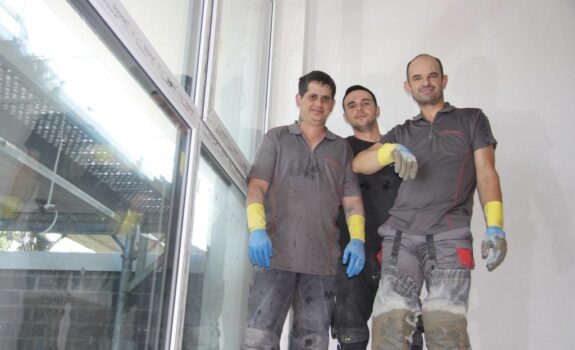Screed & Industrial Floors

When it comes to screed, it’s all about the right mixture
We work with future-proof building materials and technologies for screeds and industrial floors.
The term screed refers to the construction of the floor as a level substrate for floor coverings. In addition to its function as a “filler and levelling material”, a screed is primarily to be regarded as a load distribution layer under which heating systems, heat and sound insulation can be located. It can also be the direct wear layer.
A screed is a base for floor coverings and serves to straighten floors as well as for heat and impact sound insulation. The screed makes it possible to lay floor coverings as the top layers.
Function:
- Distribute the pressure evenly over the insulation underneath
- even substrate for a floor covering
- immediate usability
- to achieve a given height etc.
Our services in the area of screed
- Floor technology for residential construction
- Basement screeds - Balcony screeds - Garage screeds - Underlayment screeds for all types of floor coverings
- Floor technology for public and commercial buildings
- Bonded screed
- Floating screed
- Heating screed (screed especially for underfloor heating)
- Lightweight screed
- Industrial floor
- Anhydrite screed
- Calcium sulphate flowing screed
- Epoxy resin screed
- Cement screed
- Grinding and repair of screed floors
- Floor coating
Installation types
- Screed on insulation layer
- Screed on separating layer
- Bonded screed
- Heating screed
- Levelling screed - Sloping screed
- Synthetic resin screed
Other services:
- Industrial screed
- Rapid screed
- Floor coatings
- Thin-layer screed
- Demolition work / screed removal and disposal
- Waterproofing
- Underfloor heating
- Tiling
- Insulation fill (bonded fill, cement-bonded fill)
- Hard aggregate screed
Not all screeds are the same. Different screeds come into question depending on the subfloor, intended use and type of load. Costs, the type of space and the time available also play a role.
What types of screed are there?
Screeds are differentiated according to their binders:
Floating screed lies on an expressly suitable and sufficiently loadable impact sound insulation board or heat insulating layer made of mineral fibres, plastics or natural insulating materials. It is movable on its base and has no direct connection with the adjoining building components. It is used to improve the thermal or impact sound insulation of the floor construction. An edge strip is required so that the screed has no contact at any point. The screed should be at least 4 cm thick.
Screed on a separating layer is separated from the load-bearing substrate by a thin intermediate layer. The separating layer must be water-repellent and is usually made of 0.1 mm thick PE foil. The surface of the load-bearing substrate should not have any punctiform elevations, loose components and mortar residues. Screed on separating layer is used if ceilings are subject to heavy bending loads or the supporting concrete is water-repellent.
Bonded screed is a screed that is permanently bonded to the supporting concrete. Perfect adhesion largely determines the quality of the bonded screed. Accordingly, a sufficient roughness of the supporting concrete is an essential prerequisite for good screed. The bonded screed is especially suitable when the floor is exposed to particularly high mechanical stresses.
Underfloor heating systems are increasingly being used today. Comfort and the avoidance of coldness underfoot characterise the mode of operation of an underfloor heating system. Heating screed is a heatable screed that is usually laid as a screed on an insulating layer. Heating screed does not differ in its composition from normal screed, but it must not attack the heating pipes. It must not contain any aggressive components that could damage the plastic pipes. The screed covering of the heating system is usually at least 45 mm.
Rapid screed is an ideal product for interior use in residential, office and administrative buildings as well as hotels, schools, kindergartens, etc. It can be walked on and laid in a very short time. Due to the very fast drying, construction times can be extremely shortened with rapid screeds. The disadvantage of this screed is the relatively low compressive strength of approx. 20 N/mm, which limits its use to certain areas.
Industrial screed is primarily installed in industrial or commercially used rooms. It is also used in warehouses of all kinds, car parks or airport facilities. This screed must withstand considerable stress, e.g. from passenger and vehicle traffic. The advantages are high mechanical strength, high thermal stability, good chemical resistance and high abrasion resistance.
Cement screed probably the most commonly used type of screed. It contains almost the same components as concrete and is therefore also called concrete screed. It is particularly resistant to water after hardening, but does not have particularly good insulating properties. It should be avoided for floor areas larger than 36 square metres, as cracks can potentially form.
Due to its good strength values and high resistance to moisture, it is particularly suitable for indoor and outdoor use. In addition, it is known as a heating screed for the installation of underfloor heating systems. The drying time until ready for covering is between 20 and 30 days.
Calcium sulphate screed
Another popular type of screed is anhydrite screed – or calcium sulphate screed. Since it conducts heat particularly well and causes little tension, it is especially popular as a heating screed. Calcium sulphate (burnt gypsum) is used as a binder. Its great advantage over cement screed is that it can be walked on much faster. It is also dimensionally stable and crack-free. The addition of synthetic resin dispersions further increases its strength. Calcium sulphate screed is processed in the same way as cement screed.
Conventional anhydrite screed
The anhydrite screed is conventionally mixed earth-moist like the cement screed, but with anhydrite as binder instead of cement. Anhydrite binder is gypsum-based and therefore not suitable for outdoor use.
Epoxy resin screed is a robust and resistant screed that is particularly suitable for wet areas such as floor-level showers or laundry rooms. Advantages are water resistance, resilience and flexibility, while disadvantages are high cost and necessary additional flooring.
Lightweight screed is an alternative to ordinary cement screed. Lightweight aggregates made of expanded shale are added to the screed, which can reduce the total weight by about one third for the same screed thickness. In addition to cement, a lightweight screed also contains additives that make the screed lighter. A ready-to-use lightweight screed is a fast-hardening, hydraulically bound levelling insulation.
How long does it take for the screed to dry?
For the subsequent installation of a floor covering, it is necessary that the screed has dried sufficiently. Especially if underfloor heating has also been installed, it is very important to observe the drying time. Otherwise, consequential damage can quickly occur. The drying time depends on various factors:
- Screed type
- Thickness of the laid screed layer
- Type of after-treatment
- Type of screed laid
- Ventilation and indoor climate
Screed that is laid together with underfloor heating generally dries faster than unheated screed. When the screed has a certain residual moisture, a sufficient drying time has been reached. This is also called equilibrium moisture. Once this condition has been reached, the rest of the floor construction can begin.
How much does a square metre of screed cost?
There are many factors that determine the price of screed construction. Here are some of them listed:
- How high is the screed structure?
- What type of screed is to be used?
- Will additives be used for faster drying?
- How large is the volume of the project?
- and many other factors.
But we can reassure you. We will always find a way to work with you to find a high-quality screed at an affordable price.
